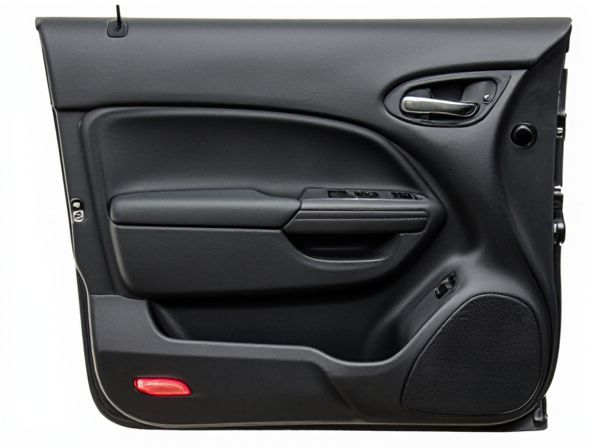
Photo illustration: Soft-Close Door vs Standard Latch Door
Soft-close doors provide a quieter, smoother closing experience by using hydraulic dampers that prevent slamming and reduce wear on hinges over time. Standard latch doors rely on mechanical latches that create noticeable noise and impact, which can lead to quicker deterioration of door components. Choosing a soft-close door enhances the longevity and comfort of your living space by minimizing noise and damage.
Table of Comparison
| Feature | Soft-Close Door | Standard Latch Door |
|---|---|---|
| Closing Mechanism | Automatic, slow, controlled closure | Manual, quick, basic latch |
| Noise Level | Quiet, minimal noise | Loud, audible click |
| Safety | Prevents door slamming, reduces injury risk | Higher risk of pinching and slamming injuries |
| Durability | Less wear and tear on door and frame | More prone to damage from hard closures |
| Convenience | Hands-free or gentle push to close | Requires full manual force to latch |
| Cost | Higher initial cost | Lower upfront cost |
Introduction to Door Mechanisms
Soft-close doors utilize hydraulic or pneumatic dampers to gently slow door movement, preventing slamming and reducing noise, while standard latch doors rely on mechanical latches that secure the door with a simple catch mechanism. The soft-close mechanism enhances durability by minimizing impact stress on hinges and frames, creating a smoother user experience ideal for cabinets and furniture. In contrast, standard latch doors provide straightforward operation with immediate closure but may cause wear over time due to abrupt stopping forces.
What is a Soft-Close Door?
A soft-close door features a hydraulic or pneumatic mechanism that slows the door's motion as it closes, preventing slamming and reducing noise. Unlike standard latch doors, which rely on a basic catch to keep the door shut, soft-close doors ensure a smooth, controlled closure for enhanced durability and user comfort. This technology is commonly used in kitchen cabinets, closets, and interior doors to improve functionality and door lifespan.
What is a Standard Latch Door?
A standard latch door uses a spring-loaded mechanism that holds the door closed by engaging a latch into a strike plate, requiring manual force to open and close. This type of door can produce noise when slamming shut and may cause wear over time. It is commonly found in residential and commercial settings due to its simplicity and cost-effectiveness.
Key Features of Soft-Close Doors
Soft-close doors feature hydraulic or pneumatic dampers that ensure smooth, quiet closing by preventing slamming, enhancing durability and reducing noise pollution. These doors commonly include integrated soft-close hinges and latch mechanisms designed for controlled, gentle movements, which protect door frames and hardware from wear. Energy efficiency is improved as soft-close technology helps maintain better insulation by ensuring doors close tightly every time, unlike standard latch doors that may close abruptly or fail to seal properly.
Key Features of Standard Latch Doors
Standard latch doors feature a simple mechanical latch mechanism that holds the door closed with a spring-loaded bolt engaging the strike plate. These doors offer straightforward installation and maintenance, commonly found in residential and commercial buildings due to their reliability and affordability. Unlike soft-close doors, standard latch doors do not prevent slamming, which can lead to louder noise and potential wear over time.
Comparative Durability: Soft-Close vs Standard Latch
Soft-close doors feature hydraulic or pneumatic dampers that reduce impact, significantly extending the lifespan of hinges and door panels compared to standard latch doors, which experience higher wear from abrupt closing forces. The consistent, controlled closing motion of soft-close mechanisms minimizes stress on door frames and hardware, enhancing long-term durability. Standard latch doors often require more frequent maintenance or replacement due to damage caused by slamming and mechanical strain.
Noise Levels and User Experience
Soft-close doors significantly reduce noise levels by incorporating dampening mechanisms that gently slow door closure, preventing loud slams common in standard latch doors. This feature enhances user experience by promoting a quieter environment and reducing wear on door components, resulting in smoother, more controlled operation. Standard latch doors often produce abrupt noises and can cause vibrations, detracting from comfort and potentially leading to quicker hardware deterioration.
Installation and Maintenance Differences
Soft-close doors require precise installation with specialized hinges or dampers designed to slow door movement for smooth closing, compared to standard latch doors that use simpler, more conventional hinges or magnetic latches. Maintenance for soft-close mechanisms involves occasional lubrication and inspection of dampers to ensure proper function, whereas standard latch doors typically need minimal upkeep, often limited to tightening screws or replacing worn latches. Installation time for soft-close doors tends to be longer due to alignment sensitivity, while standard latch doors allow quicker, straightforward mounting with basic tools.
Cost Analysis: Soft-Close vs Standard Latch
Soft-close doors typically cost 20-40% more upfront than standard latch doors due to advanced hydraulic or pneumatic mechanisms that reduce noise and wear. While the initial investment is higher, soft-close doors can decrease long-term maintenance expenses by minimizing impact damage and hinge replacements. Standard latch doors present lower initial costs but may incur additional repair and replacement costs over time due to frequent slamming and mechanical wear.
Which Door Type is Right for You?
Soft-close doors feature hydraulic mechanisms that prevent slamming, providing noise reduction and enhanced durability, ideal for kitchens and bathrooms where frequent use occurs. Standard latch doors rely on traditional mechanical latches, offering simplicity and cost-effectiveness, suitable for budget-conscious projects or less frequently used spaces. Choosing between soft-close and standard latch depends on priorities such as noise control, maintenance, durability, and overall budget constraints.
 caratoz.com
caratoz.com